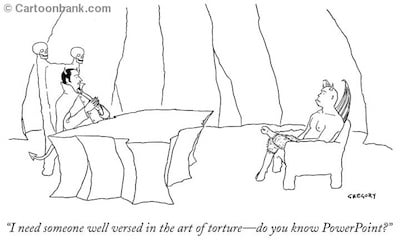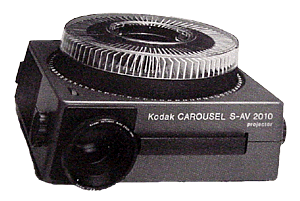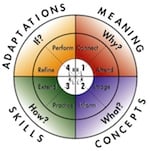If you want to read more about Waterboarding, please follow this link, or if you feel strongly about the ill-treatment of foreign prisoners in US custody click on this link, as the rest of this story is about the misuse of PowerPoint by sales, marketing and technical people in front of innocent audiences.
Having to sit through bad PowerPoint presentations can seem like a mild form of torture for the audience, inflicted usually by a sales or marketing person under the guise of presenting a solution or informing the prospective client in more detail, the worth of your offerings.
I was at the recent Marketing conference in San Francisco, attended by high caliber marketing professionals and saw a lot of bad PowerPoint presentations delivered by marketing executives. Presumably the excuse for the poor presentation being, I didn't have time to create a stunning presentation for this one-off industry event, so I created this one on the plane on the way over, anyway they were peers not prospects in the audience. What constitutes a bad PowerPoint presentation?….many factors, I like Seth Godin's take on really bad PowerPoint, but let's agree that you know you are in one when it's happening.
PowerPoint is a great presenters tool, but terrible for the audience unless handled with great care, preparation and rehearsal, yet we still do PowerPoint to our peers and ourselves, laboring lengthy, bullet-laden, text heavy and product-centric rants that fast become boring and invoke deep smart phone trances.
What’s wrong with a Product Presentation?
Product presentations have been carried forward as part of a marketing and sales culture that pre-dates the Internet. Up until about 15 years ago, buyers would invite sales people in to hear about capabilities of new products and technologies, because they had problems to solve and the salesperson, brochures and slide presentations were the medium for the message.Today the concept of the product presentation as part of the sales process is obsolete, yet it’s alive and thriving in its post-Internet form in millions of PowerPoint presentations. Buyers no longer need or want product presentations because they can find out all they need to know about your product and how it's rated with couple of mouse clicks.
The reality is that nobody cares about your products or services - except you, and maybe your colleagues. People really care about getting their needs met, solving their business problems and achieving their goals.
The Purpose of a Sales Presentation
What are you trying to achieve with your presentation?If you are in sales, I'll give you my definition. "The purpose of a sales presentation is to have the audience interact with both the presenter and the material to engage, transform and activate the audience to create change."
Why Visual Storytelling
Visual storytelling is as old as our civilization and cave-man drawings are our link with pre-history. Simple images, coupled with a story that engages the buyer in conversation and creates a fabric of understanding are an order of magnitude more effective than the average PowerPoint product presentation.Using Whiteboarding for Discovery and Storytelling
The best presentations are conversations and the best way to start a conversation is in a discussion around issues affecting the buyer. Using a whiteboard is a wonderful way to capture the elements of that conversation, to document the trends and issues affecting the buyer and capture the challenges facing the buyer in achieving their goals. A whiteboard is also an excellent tool for opening a discussion with an opinion about the buyer condition to provoke a response and engagement.
Having established the buyer condition and the need for your product or service you can tell your story using simple images on the whiteboard, adding relevant facts, proof points and all the while confirming with the buyer that your story is relevant and your capabilities are of value. If during the discovery process you learn that the buyer does not have a condition that you can help solve, then it will be a short meeting and you won't deliver your story.
Which meeting would you prefer to be in as a buyer? The PowerPoint whipping or the whiteboard conversation?








